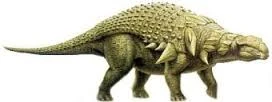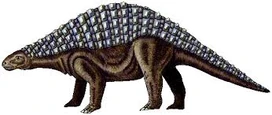
Panoplosaurus (meaning "completely or totally armoured lizard") is a genus of nodosaurid dinosaur. It was one of the last known nodosaurids, living during the Late Cretaceous in what is now North America; fossils have been located in Alberta, Canada.
The first fossil was found in 1917 by Charles M. Sternberg in Quarry 8, near Little Sandhill Creek. The type species Panoplosaurus Mirus was named by Lawrence M. Lambe in 1919. The generic name is derived from Greek pan, "completely" and hoplon, "armour". The specific name means "wondrous" in Latin.[1]
Depiction of megaherbivores in the Dinosaur Park Formation, Panoplosaurus on the far right
This holotype, CMN 2759, was discovered in the Dinosaur Park Formation dating from the late middle Campanian, 76 million years ago.[2] It consists of the complete skull with lower jaws, the cervical vertebrae, some dorsal vertebrae and some ribs. Part of the bony armour scutes or osteoderms were preserved. Later two more large specimens were found, again containing skulls but also providing some information about the shoulder girdle and front limbs: ROM 1215[3] and RTMP 83.25.2. Panoplosaurus was 5.5 to 7.5 metres (18 to 25 ft) long, around 2 metres (6.6 ft) tall[citation needed], and had an estimated weight of 1.6 tonnes (1.8 short tons).[4] It was heavily armoured, even by the standards of other nodosaurs, probably with traverse bands of studded plates covering its back and tail, although the tail likely lacked the club found in ankylosaurids. Larger paired ovals of bony armour covered the neck, shoulders and front limbs. These ovals were keeled, possessing a prominent curved ridge on the outer surface. Spikes on the shoulder, that some other nodosaurids featured, were absent. The armour on the head was fused into a compact helmet-like shield; these plates had a lumpy surface. Also bony cheek scutes were present.[5]

The skull was short and wide at the back. The head of the holotype specimen is particularly rounded; the other two skulls are longer and flatter, perhaps reflecting age or gender differences. The animal had a relatively narrow snout, perhaps to aid in rooting about for low growing plants to eat and indicating a selective diet of highly nutritious food. Although the coracoid was slender and not fused to the scapula, the forelegs were particularly heavy, and had attachments for large muscles, which may suggest that the animal would have been surprisingly maneuverable in life, possibly being able to make defensive charges like a modern rhinoceros.[6] The hand perhaps had only three fingers. The pelvis was attached to four sacral vertebrae with short sacral ribs.
Originally assigned to the Ankylosauridae, Panoplosaurus is today considered a member of the Nodosauridae as a close relative of Edmontonia from the same formation. In 1971 Walter Coombs even referred the species of Edmontonia to a subgenus within Panoplosaurus, creating a Panoplosaurus (Edmontonia) longiceps and a Panoplosaurus (Edmontonia) rugosidens but this has found no lasting acceptance. http://dino.wikia.com/wiki/Dinosaur_Wiki:All_articles
Gallery[]
Panoplosaurus/Gallery